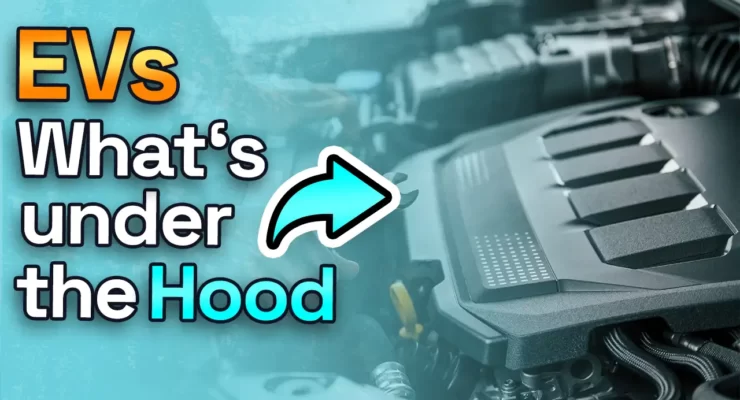Fast read
Electric vehicles (EVs) do not have an internal combustion engine but are powered by an electric motor which is part of the powertrain system.
The powertrain also includes a power electronic controller, which manages the charging of the battery and the motor's power supply. Two types of electric motors available in EVs are AC and DC, but for the main vehicle functioning, only an AC motor is required.
AC motors are divided into two types, synchronous and asynchronous, which differ in torque and efficiency. DC motors are also used in some applications in EVs, such as for running windshield wipers. However, their use is limited because of the higher wear and tear of their commutators and brushes.
EVs offer several advantages over internal combustion vehicles, including higher efficiency, smaller size, instant and constant torque, lower maintenance, and emission-free driving.
What’s under the hood of an electric car, an engine or a motor?
Electric cars are speeding into the limelight, becoming more and more prevalent on our roads. But a question often lingers in the minds of many prospective buyers and curious onlookers: Do electric cars have an engine?
The simple answer is no, at least not in the traditional sense. Here’s what you need to know about the innovative technology that propels these vehicles. You will also learn why they are shaping up to be the future of driving.
The electric car revolution
Traditional vehicles have an internal combustion engine. This means the engine bay is filled with hoses, valves, and what seems like a complicated plumbing process. Electric cars, on the other hand, are powered by electric motors connected to a battery. This system allows them to operate with only a single moving part, translating to lower service costs and longer operational life.
Where is the engine in my electric car?
Electric cars are wholly dependent on electricity, otherwise known as AEVs or battery electric cars. They are powered by an electric motor rather than an internal combustion engine. The electric motor is powered by a large traction battery pack, which must be hooked into a wall outlet or charging equipment. This is commonly known as electric vehicle supply equipment (EVSE).
Because it is powered by electricity, there are no emissions from the tailpipe. There are also no standard liquid fuel components such as a fuel pump, fuel line, or fuel tank.

What are the different engine types in an electric car?
In electric cars, the motor is part of a more extensive system known as the powertrain, which allows the motor to function. In this powertrain, you will find the Power Electronic Controller, which combines different components. This controls the charging of the battery and the motor’s power supply, as well as adjusting the torque and speed of the rotation transmitted from the motor to the wheel.
Two main types of motor are available for electric cars, either AC or DC. Alternating current (AC) and Direct current (DC) are two types of electricity flow. As the names suggest, direct current is when the energy can only flow in one direction, whereas alternating current allows energy to flow in both directions.
An AC motor is required for the primary vehicle functioning, such as driving. However, motors powered by DC energy can also be found in an electric car. This is, however, only for small tasks like running windshield wipers. So in specific terms, electric cars have one major type of motor that allows them to drive and function properly – AC motors.
AC motors
Two types of AC motors are available in electric cars, asynchronous and synchronous motors. In a synchronous motor, the rotor turns at the same speed as the magnetic field. This allows for higher torque at lower speeds, making it more efficient for urban city driving. Compared to an asynchronous motor, a synchronous motor is much smaller, allowing for a more compact and lighter vehicle.
The other asynchronous option is a motor where the rotor is pulled into a spin where it is always trying to reach the rotating magnetic field. This motor is known for its ability to have a higher power output.
Overall, electric manufacturers are producing over 95% efficient motors passing internal combustion vehicles, with some averaging as low as 50%. The other advantages of electric motors are;
- They are smaller and weigh less
- They are cheaper to produce
- They can provide instant and constant torque at any speed
- They have far fewer moving parts which means they require less maintenance
The engine in an electric car is usually smaller than the traditional combustion engine, and they are always located in the front of the vehicle.

DC motors
In most circumstances, a DC motor operates on voltages ranging from 95 to 192 volts. Furthermore, more torque is created by DC motors, an aspect that can cut costs.
DC motors are divided into three types: brushed DC motors and brushless DC motors. In electric automobiles, brushed DC motors are commonly used for folding, adjusting, and extending electrically driven side windows. Because of their low cost, these motors are suited for a wide range of applications.
However, the commutators and brushes wear quickly because of their constant contact. This means regular maintenance or replacement.
As the name indicates, a brushless motor does not utilise brushes and instead uses an electronic commutator. This boosts efficiency and dependability by removing the power source and wear loss. These motors have considerable benefits over induction and brush DC motors. Including; greater speed ranges, noiseless operation, faster dynamic response, superior speed versus torque characteristics etc.
What’s next for electric cars?
The shift toward all-electric cars is expected to grow, with conventional-engine vehicles being phased out gradually. Innovations like two-speed gearboxes are being explored to enhance efficiency at higher speeds. The future of driving looks electric, and the industry shows no sign of slowing down.
A new era of transportation
Electric cars are revolutionising how we think about transportation. They don’t have an engine in the conventional sense, but rather a highly efficient and advanced electric motor system. As technology continues to advance and the world leans more towards environmentally friendly options, electric cars stand at the forefront of this shift, promising a more sustainable future on the road.
Whether you’re a tech enthusiast, an environmental advocate, or simply looking for a smooth and quiet ride, electric cars offer a compelling alternative. Next time you find yourself pondering, “Do electric cars have an engine?” remember, they have something even better—a technology that’s redefining the fundamental essence of driving.


